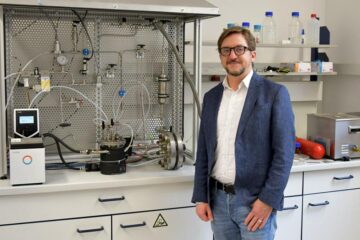Fighting the Colorado potato beetle with RNA interference

Colorado potato beetle (CPB): On average 40 to 50 cm2 of leaf material are eaten by each of the beetles’ larvae. Infestation with CPB can result in crop losses up to 50 %, if there is no pest control. ©Sher Afzal Khan, Max Planck Institute for Chemical Ecology
Colorado potato beetles are a dreaded pest of potatoes all over the world. Since they do not have natural enemies in most potato producing regions, farmers try to control them with pesticides. However, this strategy is often ineffective because the pest has developed resistances against nearly all insecticides.
Now, scientists from the Max Planck Institutes of Molecular Plant Physiology in Potsdam-Golm and chemical Ecology in Jena have shown that potato plants can be protected from herbivory using RNA interference (RNAi). They genetically modified plants to enable their chloroplasts to accumulate double-stranded RNAs (dsRNAs) targeted against essential beetle genes. (Science, February 2015).
RNA interference (RNAi) is a type of gene regulation that naturally occurs in eukaryotes. In plants, fungi and insects it also is used for protection against certain viruses. During infection, many viral pathogens transfer their genetic information into the host cells as double-stranded RNA (dsRNA). Replication of viral RNA leads to high amounts of dsRNA which is recognized by the host‘s RNAi system and chopped up into smaller RNA fragments, called siRNAs (small interfering RNAs). The cell then uses siRNAs to detect and destroy the foreign RNA.
But the RNAi mechanism can also be exploited to knock down any desired gene, by tailoring dsRNA to target the gene's messenger RNA (mRNA). When the targeted mRNA is destroyed, synthesis of the encoded protein will be diminished or blocked completely. Targeting an essential gene of a crop pest can turn dsRNA into a precise and potent insecticide.
Some crop plants have recently been engineered by modifying their nuclear genomes to produce dsRNA against certain insects. „This never resulted in full protection from herbivory“, says Ralph Bock of the Max Planck Institute of Molecular Plant Physiology, „because the plant's own RNAi system prevents the accumulation of sufficient amounts of dsRNA. We wanted to circumvent this problem by producing dsRNA in the chloroplasts instead“.
These organelles, which perform photosynthesis in green plants, are descendants of formerly free-living cyanobacteria, which are prokaryotes that lack an RNAi system. Presuming that chloroplasts would accumulate high amounts of dsRNA, the scientists in Ralph Bock's group decided to generate so-called transplastomic plants. In such plants, the chloroplast genome is the target of genetic modification instead of the nuclear genome.
To test this system on a real insect pest, the scientists chose the Colorado potato beetle. This little striped beetle was introduced into Europe accidentally at the end of the 19th century. Nowadays, it is a worldwide pest and can cause massive damage in agriculture. Besides potato leaves the adult beetle and its larvae also feed on other nightshade crops, like tomato, bell pepper and tobacco. The pest is difficult to control because of the widespread occurrence of insecticide resistance. „By using chloroplast transformation we generated potato plants that accumulate high amounts of long stable dsRNAs targeting essential genes in the beetle“, says Ralph Bock.
The efficacy of the dsRNAs as an insecticide was tested at the Max Planck Institute for Chemical Ecology in Jena. Larvae were fed on detached potato leaves and the mortality was monitored for nine days. The leaves were taken from transplastomic dsRNA plants, conventional transgenic dsRNA plants with a modified nuclear genome, and unmodified plants. For comparison, dsRNAs targeting two different genes were tested.
„Transplastomic leaves producing dsRNA against the actin gene caused a mortality rate of 100% after five days of feeding“, says Sher Afzal Khan from Jena. The actin gene encodes a structural protein that is essential for cell integrity. In contrast, plants with a modified nuclear genome expressed much less dsRNA and only slightly slowed down the beetles' growth.
These recent results show that changing the target of transformation from the nuclear genome to the chloroplast genome overcomes the major hurdle towards exploiting RNAi for crop protection. As many insect pests increasingly develop resistances against chemical pesticides and Bt toxins, RNAi represents a promising strategy for pest control. This technology allows for precise protection without chemicals and without production of foreign proteins in the plant.
KD/AO
Contact
Prof. Dr. Ralph Bock
Max Planck Institute of Molecular Plant Physiology
Tel. 0331/567 8211
RBock@mpimp-golm.mpg.de
http://www.mpimp-golm.mpg.de/7889/dep_3
Dr. Kathleen Dahncke
Press and public relations
Max Planck Institute of Molecular Plant Physiology
Tel. 0331/567 8275
dahncke@mpimp-golm.mpg.de
http://www.mpimp-golm.mpg.de
Angela Overmeyer
Press and public relations
Max Planck Institute for Chemical Ecology
Tel. 03641/572 110
overmeyer@ice.mpg.de
http://www.ice.mpg.de
Original publication:
Jiang Zhang, Sher Afzal Khan, Claudia Hasse, Stephanie Ruf, David G. Heckel, Ralph Bock; Full crop protection from an insect pest by expression of long double-stranded RNAs in plastids; Science, February 27th, 2015
http://www.mpimp-golm.mpg.de – Max Planck Institute of Molecular Plant Physiology
http://www.ice.mpg.de – Max Planck Institute for Chemical Ecology
Media Contact
Alle Nachrichten aus der Kategorie: Biowissenschaften Chemie
Der innovations-report bietet im Bereich der "Life Sciences" Berichte und Artikel über Anwendungen und wissenschaftliche Erkenntnisse der modernen Biologie, der Chemie und der Humanmedizin.
Unter anderem finden Sie Wissenswertes aus den Teilbereichen: Bakteriologie, Biochemie, Bionik, Bioinformatik, Biophysik, Biotechnologie, Genetik, Geobotanik, Humanbiologie, Meeresbiologie, Mikrobiologie, Molekularbiologie, Zellbiologie, Zoologie, Bioanorganische Chemie, Mikrochemie und Umweltchemie.
Neueste Beiträge

Ideen für die Zukunft
TU Berlin präsentiert sich vom 22. bis 26. April 2024 mit neun Projekten auf der Hannover Messe 2024. Die HANNOVER MESSE gilt als die Weltleitmesse der Industrie. Ihr diesjähriger Schwerpunkt…

Peptide auf interstellarem Eis
Dass einfache Peptide auf kosmischen Staubkörnern entstehen können, wurde vom Forschungsteam um Dr. Serge Krasnokutski vom Astrophysikalischen Labor des Max-Planck-Instituts für Astronomie an der Universität Jena bereits gezeigt. Bisher ging…

Wasserstoff-Produktion in der heimischen Garage
Forschungsteam der Frankfurt UAS entwickelt Prototyp für Privathaushalte: Förderzusage vom Land Hessen für 2. Projektphase. Wasserstoff als Energieträger der Zukunft ist nicht frei verfügbar, sondern muss aufwendig hergestellt werden. Das…





















